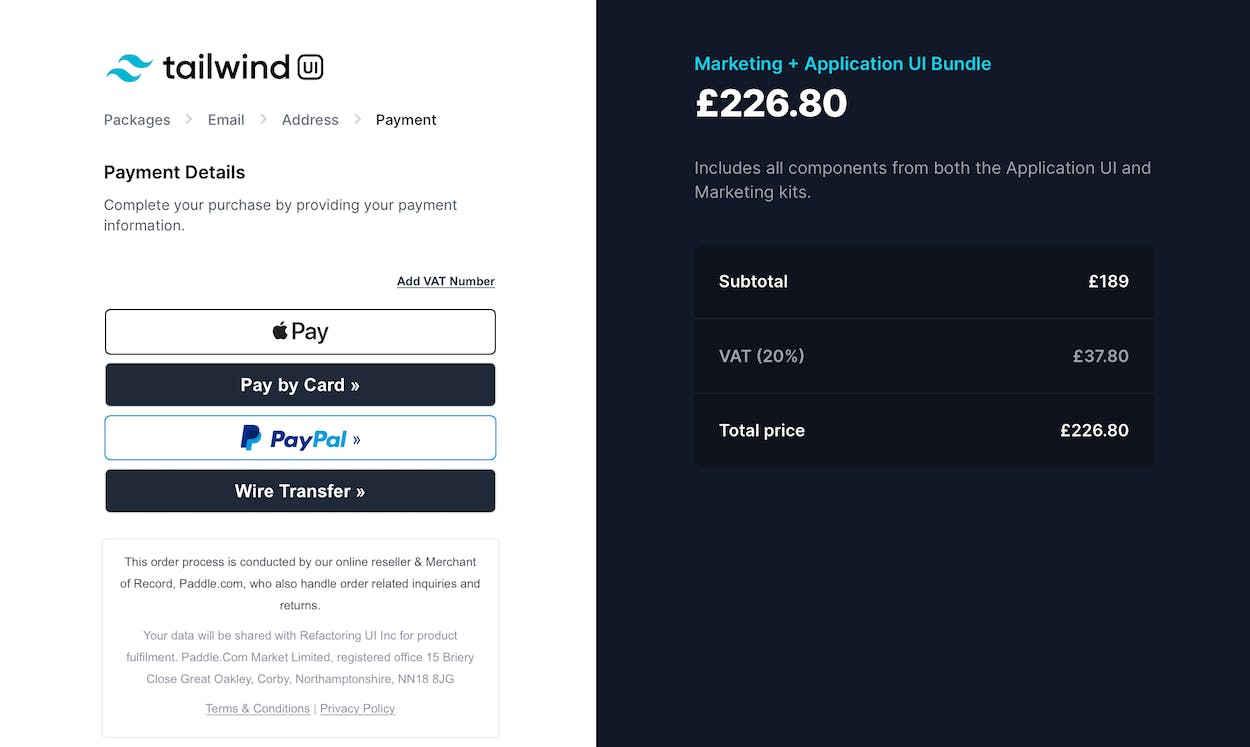Managing payments infrastructure
Tailwind Labs CEO Adam Wathan is no stranger to the billing and payments landscape. Having built integrations with payment service providers in the past (and inadvertently becoming a payments expert in the process), he wanted to take a different approach with Tailwind UI – using a merchant of record or reseller that would handle all elements of the business’ payments infrastructure
Adam was hoping this model would offer relief from sales tax liabilities and reduce the admin burden of bookkeeping. But after finding a provider and getting set up, there was still an underlying concern over its stance on sales tax and what would happen if they were audited by the Canadian Revenue Agency (CRA).
“We always had an undercurrent of anxiety around sales tax. Gumroad handled some of it for us but didn’t really have a solid stance on who was ultimately liable.”
In 2020, Gumroad was impacted by changes to PayPal’s terms and requested that clients manage their payments through PayPal directly. This new requirement made Adam’s concerns about sales tax a reality and meant a lot more work to manage payments in-house. Adam explains:
“I’d actively avoided making my own PayPal account, it’s not a service I enjoy working with and it would really complicate our bookkeeping because we’d have to manage every payment, rather than payouts. Also, using our own account makes us the merchant and definitely liable for sales tax.”
A unified solution
Tailwind Labs realized they had two choices:
- A piecemeal approach, stitching together payment service providers (like Stripe and PayPal) and other tools to manage subscriptions and taxes (and ultimately managing tax liability in-house).
- Or a unified platform committed to handling all aspects of payments infrastructure for its customers.
On the surface, the unified platforms appeared more expensive. But digging a little deeper Adam found that piecemeal providers had complex fee structures that included additional charges on top of the base fee for cross-border payments and foreign exchange.
“With our cross-border payments, we were looking at around 3.5% fees with Stripe and 4.5% with PayPal. So, any savings would have been minimal.”
For Adam, it wasn’t worth the extra tax management and admin it would bring to the team.
“You just ask yourself, is any saving worth the admin burden and opening yourself up to extra scrutiny from the tax agencies? Absolutely not.”
That’s when he contacted Paddle. As a merchant of record and provider of payments infrastructure for SaaS, Paddle takes on all tax liability for the transactions to all end customers, absolving Tailwind Labs from any non-compliance.
Taking control…. Without the headaches
Since migrating to Paddle, Adam has been able to relax, safe in the knowledge that he doesn’t need to worry about sales tax and that he will only have to add Paddle payouts to the books.
On top of this, Paddle products Comply and Managed Payments have teams of people and the technology to continually optimize these processes. Adam says:
“[With Paddle,] we don’t have to worry about new markets charging tax on software. We can accept more payment methods now, including wire transfer and Apple Pay. It’s great because our checkout is almost self upgrading. We’ll be able to use more payment methods as they become popular because Paddle will make them available for us.”
Tailwind Labs was also one of the first sellers to utilize Paddle’s Branded Inline Checkout, creating an integrated experience, rather than the hosted redirect checkout they had before:
“We have a lot more control over the checkout experience now. It’s on brand and cohesive with our website, which really increases customer trust in the experience."
“So far, we couldn’t be happier with Paddle.”

